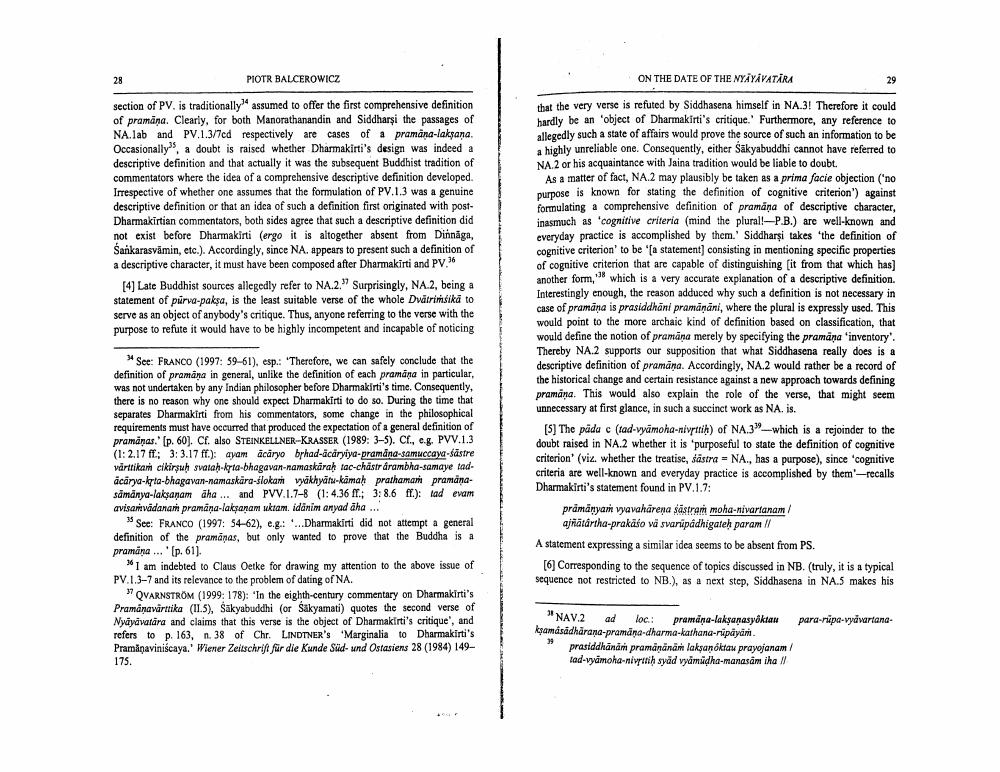Book Title: On The Date Of The Nnyayavatara Author(s): Piotr Balcerowicz Publisher: Piotr Balcerowicz View full book textPage 7
________________ PIOTR BALCEROWICZ ON THE DATE OF THE NYAYAVATĀRA section of PV. is traditionally assumed to offer the first comprehensive definition of pramāņa. Clearly, for both Manorathanandin and Siddharşi the passages of NA.lab and PV.1.3/7cd respectively are cases of a pramana-laksana. Occasionally, a doubt is raised whether Dharmakirti's design was indeed a descriptive definition and that actually it was the subsequent Buddhist tradition of commentators where the idea of a comprehensive descriptive definition developed. Irrespective of whether one assumes that the formulation of PV.1.3 was a genuine descriptive definition or that an idea of such a definition first originated with postDharmakirtian commentators, both sides agree that such a descriptive definition did not exist before Dharmakirti (ergo it is altogether absent from Dinnāga, Sankarasvāmin, etc.). Accordingly, since NA. appears to present such a definition of a descriptive character, it must have been composed after Dharmakirti and PV.6 [4] Late Buddhist sources allegedly refer to NA.2." Surprisingly, NA.2, being a statement of purva-paksa, is the least suitable verse of the whole Dvätrimsikā to serve as an object of anybody's critique. Thus, anyone referring to the verse with the purpose to refute it would have to be highly incompetent and incapable of noticing that the very verse is refuted by Siddhasena himself in NA 3! Therefore it could hardly be an object of Dharmakirti's critique.' Furthermore, any reference to allegedly such a state of affairs would prove the source of such an information to be highly unreliable one. Consequently, either Säkyabuddhi cannot have referred to NA 2 or his acquaintance with Jaina tradition would be liable to doubt. As a matter of fact, NA.2 may plausibly be taken as a prima facie objection ('no purpose is known for stating the definition of cognitive criterion') against formulating a comprehensive definition of pramana of descriptive character, inasmuch as 'cognitive criteria (mind the plural!--P.B.) are well-known and everyday practice is accomplished by them.' Siddharşi takes 'the definition of cognitive criterion' to be "[a statement consisting in mentioning specific properties of cognitive criterion that are capable of distinguishing it from that which has) another form, which is a very accurate explanation of a descriptive definition. Interestingly enough, the reason adduced why such a definition is not necessary in case of pramāna is prasiddhāni pramanāni, where the plural is expressly used. This would point to the more archaic kind of definition based on classification, that would define the notion of pramāna merely by specifying the pramana 'inventory Thereby NA.2 supports our supposition that what Siddhasena really does is a descriptive definition of pramāna. Accordingly, NA.2 would rather be a record of the historical change and certain resistance against a new approach towards defining pramāna. This would also explain the role of the verse, that might seem unnecessary at first glance, in such a succinct work as NA.is. [5] The päda c (tad-vyamoha-nivstrik) of NA.3"-which is a rejoinder to the doubt raised in NA.Z whether it is purposeful to state the definition of cognitive criterion (viz. whether the treatise, sastra = NA., has a purpose), since 'cognitive criteria are well-known and everyday practice is accomplished by them'-recalls Dharmakirti's statement found in PV.1.7: prāmanyam vyavahāreņa sāstram moha-nivartanam / ajñātártha-prakašo vā svarūpádhigateh param // A statement expressing a similar idea seems to be absent from PS. [6] Corresponding to the sequence of topics discussed in NB. (truly, it is a typical sequence not restricted to NB.), as a next step, Siddhasena in NA.5 makes his See: FRANCO (1997: 59-61). esp.: 'Therefore, we can safely conclude that the definition of pramana in general, unlike the definition of each pramana in particular, was not undertaken by any indian philosopher before Dharmakirti's time. Consequently, there is no reason why one should expect Dharmakirti to do so. During the time that separates Dharmakirti from his commentators, some change in the philosophical requirements must have occurred that produced the expectation of a general definition of pramanas. [p. 60). Cl. also STEINKELLNER-KRASSER (1989: 3-5), Cr, C., PVV.1.3 (1:2.17 ff: 3:3.17 ff.): ayam acaryo brhad-acaryiya-pramana-samuccaya-sastre vårttikam cikirşuh svatah-krta-bhagavan-namaskarah tac-chastr árambha-samaye tadacara-kata-bhagavan-namaskara-slokam vakhwat-kamah prathama pramanasāmānya-laksaņam aha ... and PVV.1.7-8 (1: 4.36 T.: 3:8.6 ff.): lad evam avisanvādanan pramana-laksanam uktam. idanim aryad aha.. See: FRANCO (1997: 54-62), e.g.: ....Dharmakirti did not attempt a general definition of the pramanas, but only wanted to prove that the Buddha is a pramana ... '(p. 61). *I am indebted to Claus Oetke for drawing my attention to the above issue of PV.1.3-7 and its relevance to the problem of dating of NA 57 OVARNSTRÖM (1999: 178): 'In the eighth-century commentary on Dharmakirti's Pramanavarttika (11.5), Sakyabuddhi (or Säkyamati) quotes the second verse of Nāvavatara and claims that this verse is the object of Dharmakirti's critique', and refers to p. 163, n. 38 of Chr. LINDTNER'S 'Marginalia to Dharmakirti's Pramanaviniscaya.' Wiener Zeitschrift für die Kunde Süd- und Ostasiens 28 (1984) 149– "NAV.2 ad loc: pramana-laksanasyöktan para-rpa-vyavartandkşamásadharana-pramaņa-dharma-kathana-rupayan. prasiddhānam pramanānam laksan okta prayojanam/ tad-vyamoha-nitrih svād vyāmüdha-manasam iha // 175.Page Navigation
1 ... 5 6 7 8 9 10 11 12 13 14 15 16 17 18 19 20 21
